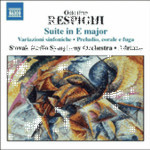
Suite in E major & other orchestral works
 $25.00
Out of Stock
$25.00
Out of Stock6+ weeks add to cart
RESPIGHI
Suite in E major & other orchestral works
Slovak Radio Symphony Orchestra / Adriano
[ Naxos / CD ]
Release Date: Wednesday 30 April 2008
This item is currently out of stock. It may take 6 or more weeks to obtain from when you place your order as this is a specialist product.
Listening to the early orchestral works of Respighi all recorded here for the first time, one would never suppose the composer to have been Italian. They belong to the earlier period of Respighi's career, before the water-shed of his development, which, in his own judgement, came at the age of 37, in 1916, the year of Fontane di Roma.
If Respighi had lived no longer than this, posterity would have seen him as a very talented Bologna composer, a former pupil of the violinist Federico Sarti, of Luigi Torchi and, for composition, of Giuseppe Martucci, with a predilection for a form of music largely neglected at that time in Italy: the symphonic. Bologna was, in fact, the centre of Germanoriented tendencies, and the whole musical atmosphere of the place, where Respighi, like Toscanini, served as orchestral players, exercised an influence on the composer that deserves further detailed treatment. Respighi had first studied German and French composers even more seriously than he had the Italian masters, writing music that contains more or less overt tributes to the former, in, for example, sonatas, quartets, orchestral suites and songs. These works he eventually put on one side, but never destroyed, although very few were published in his life-time.
Another very important influence on Respighi's early symphonic work came from the Russian school. In 1900-1 and 1902 he accepted a contract from the Imperial Theatres of St Petersburg and the Bolshoy in Moscow as a viola-player for two seasons of Italian opera. This brought him an introduction to Rimsky- Korsakov, who immediately recognised his talent and gave him lessons over a period of five months. In between his two stays in Russia, Respighi took a composer's diploma at the Conservatory of Bologna with his Preludio, corale e fuga, his second work for a large symphony orchestra. Other important events in Respighi's early career include the two periods he spent in Berlin, in 1902 as an occasional and somewhat dissatisfied pupil of Max Bruch and in 1908 as a piano coach in the singing-class of Etelka Gardini Gerster. In 1913 he was appointed professor of composition at the Liceo di Santa Cecilia in Rome, where he remained until his death in 1936.
Respighi had his Symphonic Variations performed for the first time at the Bologna Conservatory on 24th June 1900 and took the score with him to Russia, where Rimsky-Korsakov was favourably impressed by the work. Still neo-classical in form, the work gives the impression of a tribute to the romanticism of César Franck and Brahms. It consists of a series of passacaglia-like variations, preceded by an introduction and the actual passacaglia theme in D minor, transformed, in various episodes, into a march, an adagio and a scherzo. The climax comes in a fugue, introduced by the organ, leading to a triumphant restatement of the theme in D major. Already Respighi shows a masterly command of writing for brass. The orchestration includes a cor anglais, two harps and organ, with timpani, the only percussion instrument used. The Variazioni sinfoniche is still a long way from the Metamorfoseon of 1930, but shows the composer's early interest in variation form.
Tracks:
Symphonic Variations
Prelude, Chorale and Fugue
Burlesca
Carnival Overture
Suite in E major



